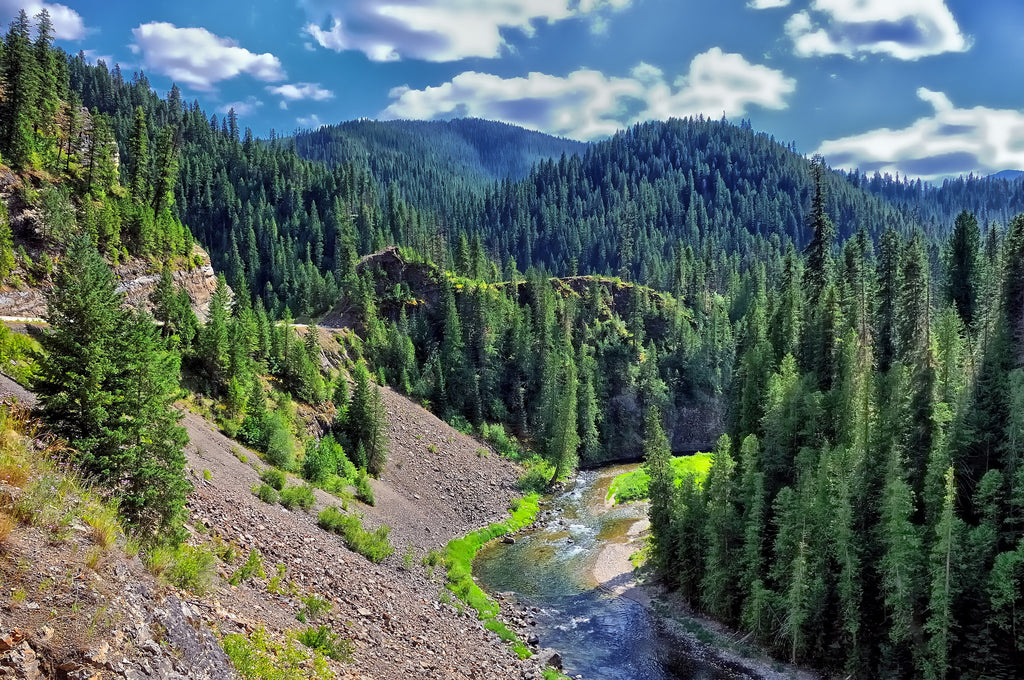All About Idaho
Posted on by Vierra Reid

As the 13th largest state in the U.S., Idaho produces 72 types of precious and semi-precious stones. Some of these stones can be found nowhere else in the world, which is why our great state is known as The Gem State.
State Flag and Seal

A silk flag, with a blue field, 5 feet 6 inches high, 4 feet 4 inches on pike is bordered by gilt fringe 2 1/2 inches wide, with the State Seal of Idaho in the center. The words "State of Idaho" are embroidered in gold block letters two inches high on a red band below the Great Seal. It was adopted by the 1907 legislature. The state seal was designed by Emma Edwards Green.
State Flower: The Syringa (Philadelphus lewisii)

The syringa was designated the state flower of Idaho by the legislature in 1931. It is a branching shrub up to 12 feet tall with clusters of white, fragrant flowers that bloom in late spring to early summer. The blossoms are similar to the mock orange, have four petals, and the flowers grow at the ends of short, leafy branches.
State Bird: The Mountain Bluebird (Sialia arctcia)

The mountain bluebird was adopted as the state bird for Idaho by the state legislature in 1931. The Bluebird is about seven inches long, has an azure blue coat, and a blue vest with white under-feathers. The mother bird wears a quiet blue-gray dress and usually lays six or seven blue-white eggs. The Bluebird’s nest is usually built in a hollow tree or in a crevice. The Bluebird is very neat about its home and carries all refuse some distance from the nest.
State Tree: The Western White Pine (Pinus Monticola pinaceae)

Our state tree is probably most notable since the largest remaining stand of this timber in the United States grows in the northern part of Idaho. Tall and slender, the Western White Pine is native to forests of the Pacific Northwest from British Columbia to Montana and as far south as central California. It has blue-green needles, slender cones and can grow to 100 ft. It has many other fine qualities such as straight grain and soft, even texture. The Western White Pine was named Idaho’s state tree in 1935.
State Horse: Appaloosa

The Appaloosa was the first horse breed to be acquired by the Nez Perce tribe around the 1700’s leading to the tribe developing into excellent horsemen and breeders. Settlers began to refer to their horses as “a Palouse horse” in reference to the Palouse River in north Central Idaho. The term evolved from that to “Palousey”, “Appalousey” and finally “Appaloosa”. An Appaloosa Horse Club was chartered in 1938 and has become one of the leading equine breed registries in the world. The Appaloosa was named Idaho’s state horse in 1975 because of its importance to Idaho history.
| State Fruit: | Wild Huckleberry |
|---|---|
| Fish: | Cutthroat Trout |
| Gem: | Star Garnet |
| Dance: | Square Dance |
| Motto: | “Esto Perpetua” meaning “It is perpetual.” |
Major Industries
- Manufacturing
- Health Care
- Tourism
- Agriculture
- Food Processing
- Timber
- Mining
National Producer Of
- Potatoes
- Trout
- Austrian Winter Peas
- Lentils
12 Largest Cities (2010 Census)
| 1. Boise: | 205,671 |
|---|---|
| 2. Nampa: | 81,557 |
| 3. Meridian: | 75,092 |
| 4. Idaho Falls: | 56,813 |
| 5. Pocatello: | 54,255 |
| 6. Caldwell: | 46,237 |
| 7. Coeur d'Alene: | 44,137 |
| 8. Twin Falls: | 44,125 |
| 9. Lewiston: | 31,894 |
| 10. Post Falls: | 27,574 |
| 11. Rexburg: | 25,484 |
| 12. Moscow: | 23,800 |
Originally posted by visitidaho.org